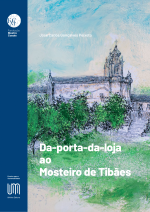From Porta da Loja to the Tibães Monastery
Keywords:
Porta da Loja apple variety, Tibães MonasterySynopsis
This work draws attention to the symbiosis between the apple “Porta da Loja” and its origin attributed to the Tibães monastery. Taking into account the circumstances and the seigneurial power, we sought, within the scope of Portuguese historiography, to connect the birthplace of this fruit with the parish of Mire de Tibães and with the extended nucleus of the Casais family, faithful custodians of this legendary heritage. We understand that the arguments presented, supported by good sources and collected data, support the hypothesis formulated, scientifically reconstituting the past, in the light of the methodologies that evolution has imprinted on local history, without losing the style that «becoming» testifies to, not only “pruning” the march of civilization, as well as rebuilding a community adapted to the demands of our time.
The focus on the “apple” was for us a meeting point between the rural world and history.
We were enchanted by this mission, this rescue in search of an old production focus. We were astonished when we found documents that focused on the discovery of old, mature apple trees in the convent fence. It was all due to the audacity of the former caretakers of the Tibães monastery, the «Casales – Casais» who, by disseminating it to the surrounding farms, did not allow this variety to fall towards extinction, in a context of green economy and the theme of sustainability.
We discovered that the “Porta da Loja” apple variety is a Benedictine heritage, produced on one of the terraces of the conventual fence, and subsequently spread across farms in the region. This gift is more than a historical and chronological memory, it is a qualitative awareness in the search for an identity, social, moral and economic legacies, as we always respect the transmission of testimonies, starting from two assumptions: point one, António Fernandes da Silva, Mestre Casais, played a leading role in the preservation, production and development of the “Porta da Loja” apple variety; point two, this businessman's family, with regard to his wife's ancestors, was the link of continuity and temporal connection to the community and the Benedictine monastery of Tibães by perpetuating the tradition and legacy of the ancestors as a symbol of the village's identity.
We seek to distribute our contribution across three parts. In the first chapter we seek to unravel the mystery surrounding the “Porta da Loja” apple variety, specifically, the connection with the monastic heritage of Tibães, as well as a historical approach to agriculture within the Benedictine sphere in general and, in particular, fruit growing on the monastery's properties. of Tibães. In the second chapter we elaborate an approach to the land ownership of the landlord of the Tibães monastery, which has known many lives. In the third chapter we provide a brief and more contemporary reference to the characterization, origins and traditions of the “Porta da Loja” apple, of which we are so proud, of what we have and what we are going to do to defend it as a fruit of choice.
Downloads








